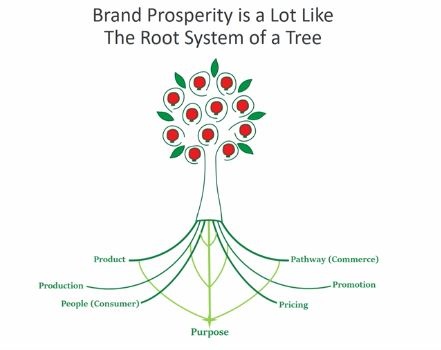
“Brand prosperity is a lot like the root system of a tree; if you think about the root system of a tree, it is hidden beneath the earth, but it is fundamental to whether or not that tree flourishes and whether or not it bears fruit … if any of the roots are weak or not functioning well, the ability of the tree to flourish is compromised.”
—Michael Movitz, The Movitz Group
The success of a brand, according to Michael Movitz, relies on an interconnected set of factors he calls the 7 P's: Purpose, product, people, pathway, pricing, and promotion of the brand.
Read more to learn how to manage these factors and achieve brand success.
Part 1: Purpose
- Your purpose is your reason for being, but there are policies and actions you must implement to achieve your purpose in a concrete and practical way.
- Who are your stakeholders (your retailers/suppliers/community)? What are their needs? You need to make sure that your branding and messaging match your purpose, and your purpose should resonate with the target consumer.

Part 2: Product strategy
- For a product to be successful at retail, you need to first figure out the product gap you are addressing, and design your product for nuanced consumer use occasions and need states.
- Think about what your product will become from a platform standpoint, don’t limit yourself. Where your product will be merchandised, its nutritional profile, its crucial and distinguishing attributes, flavor profile, and label claims are all helpful when trying to rope in consumers.
Part 3: People (consumer) strategy
- Who is the target audience? How do they shop for my kind of product? This data can be confirmed with small-scale survey results and other inexpensive forms of research.
- The number of people buying a product coupled with the frequency with which they buy the product can be manipulated after you know your consumer profile (needs, habits and drivers) better than you know your brokers, distributors and retailers.
Part 4: Pathway (commerce) strategy
- There is no longer one linear pathway; products are sold everywhere from Uber cars to e-commerce to meal kits. Where you can sell is almost limitless, so finding the right space for your product is crucial.
- People shop everywhere, but that doesn’t mean your product should be sold everywhere. Prioritize selling outlets and introduction timing.

Part 5: Pricing strategy
- Pricing has a direct correlation between how your brand is perceived from a value standpoint and its profitability.
- The goal is to have the right price at the right time in the right place and to the right consumer target.
Part 6: Promotion strategy
- Know the retail trade game: there are ways of targeting your promotion to ensure they reach the consumer; have a consumer marketing plan in place that includes sampling and events, as well as influencers
- Treat promotions as a way to express your brand’s soul, and be transparent, open and honest when promoting
- Keep track of data—"What gets measured, gets managed”
Where should you focus your resources?
- Focus on the quality (taste and efficacy) of your product first and foremost
- Then consumer champions; these are advocates who will influence others to try your products
- Make sure you keep your brand’s momentum going; the rate at which you’re selling on a constant basis should be tracked thoroughly















